One of my favorite museums in the DC area is the US Holocaust Memorial Museum. It’s a place with infinite opportunities to learn and reflect. It’s a great place to visit by yourself, and spend a day immersing yourself in the museum. It’s also one of the free D.C museums, however, it is not part of the Smithsonian Institution. The US Holocaust Memorial Council was established by Congress in 1980 in order to help raise the private funds needed to build the museum.
The museum was eventually built in 1993 and the Council became the governing board of trustees. This group is an independent establishment of the government that operates as a public/private partnerships. It has some federal funding to support the operations of the building.
There are 55 members of the board of trustees who are appointed by the President, five members from each the Senate and House of Representatives, and three ex-officio members from the Department of Education, Interior, and State. They all have various terms that last from 1 year to 5 years. They meet twice a year. Due to the size of the council, the museum also has several committees that work on various topics.
This is where things become a little hard to find information on. I can find information on the “Committee on Conscience” and the “Academic Committee”. I can’t find anything on their website about other committees, so there could potentially be more.
According to the museum’s website, “The Academic Committee is composed of experts in the field of Holocaust studies. It is an important resource for the Museum’s programs, aiming to promote research and teaching about the Holocaust into the future.”
When President Carter created the Commission on the Holocaust, which was chaired by Elie Wiesel, a Holocaust Survivor, it was determined that there would need to be a Committee on Conscience. In 1995 (2 years after the museum opened,) Leo Melamed, whose family fled Nazism, proposed the official establishment of the Committee on Conscience and the fellow Council-members approved the proposal.
According to the museum’s website, “The Committee on Conscience mandate is to alert the national conscience, influence policy makers, and stimulate worldwide action to confront and work to halt acts of genocide or related crimes against humanity.”
The mission statement for USHMM is “The United States Holocaust Memorial Museum is America’s national institution for the documentation, study, and interpretation of Holocaust history, and serves as this country’s memorial to the millions of people murdered during the Holocaust.’
Based off of my research, I can see that USHMM is a blend between a government institution and a non-profit museum. Although I was able to find quite a bit of information on the governmental structure of the museum, it wasn’t easy to track down. In effort to understand more on how these committees work together, I wish there was more information on line. I believe it is an incredible museum that does work that will never be obsolete and the collections housed there are invaluable. It was very interesting to research how this museum came to be and how it currently operates today.
My question for the class is – after researching how your museum of choice operates, do you feel any differently about the institution? (i.e do you feel a sense of clarity and truthfulness? Or was it more difficult to find information on governance, and if so, how did that make you perceive the institution?)

It was kind of a mixed bag. Some aspects of the museum felt accessible and understandable, while other felt vague and frustrating to locate. while this didn’t dramatically change my views on the Field museum, it did remind me of the importance of critical thinking and research before making committing to a final judgement.
Hey Maxine! I like that you wrote about one of your favorite museums. I have been to the Holocaust Museum and felt moved by the the displays it was very informational as I do not know much about the Holocaust era or what had happened. I would love to go back and be able to go through the exhibit again thoroughly, as I was on a work trip last time I visited. As for your question, I felt troubled, not about the museum itself, but accessing information. I find reading up on their page does not do me enough justice, it just gives me a lens to look through. i would need to see how the facility is set up and then see the people who run it and how they manage to give me a idea on a since of clarity or truthfulness.
Thanks for presenting on this uniquely situated museum – I visited in the spring of 1994 and was really blown away. I still remember aspects of the exhibits – most of all a quiet meditative space away from the exhibits that allowed for time to sit and deal with what you just witnessed. I thought this was a really smart way to help visitors manage their emotional response to an emotionally exhausting topic.
I think the question you pose is a critical one – transparency is one of the most talked about concepts in museum operations these days and if you have to dig and hunt for the guiding institutional documents for a museum, I think it says a lot about what its values are! As a public nonprofit, I think its essential that museums present their core documents in plain English and in an easy-to-find location.